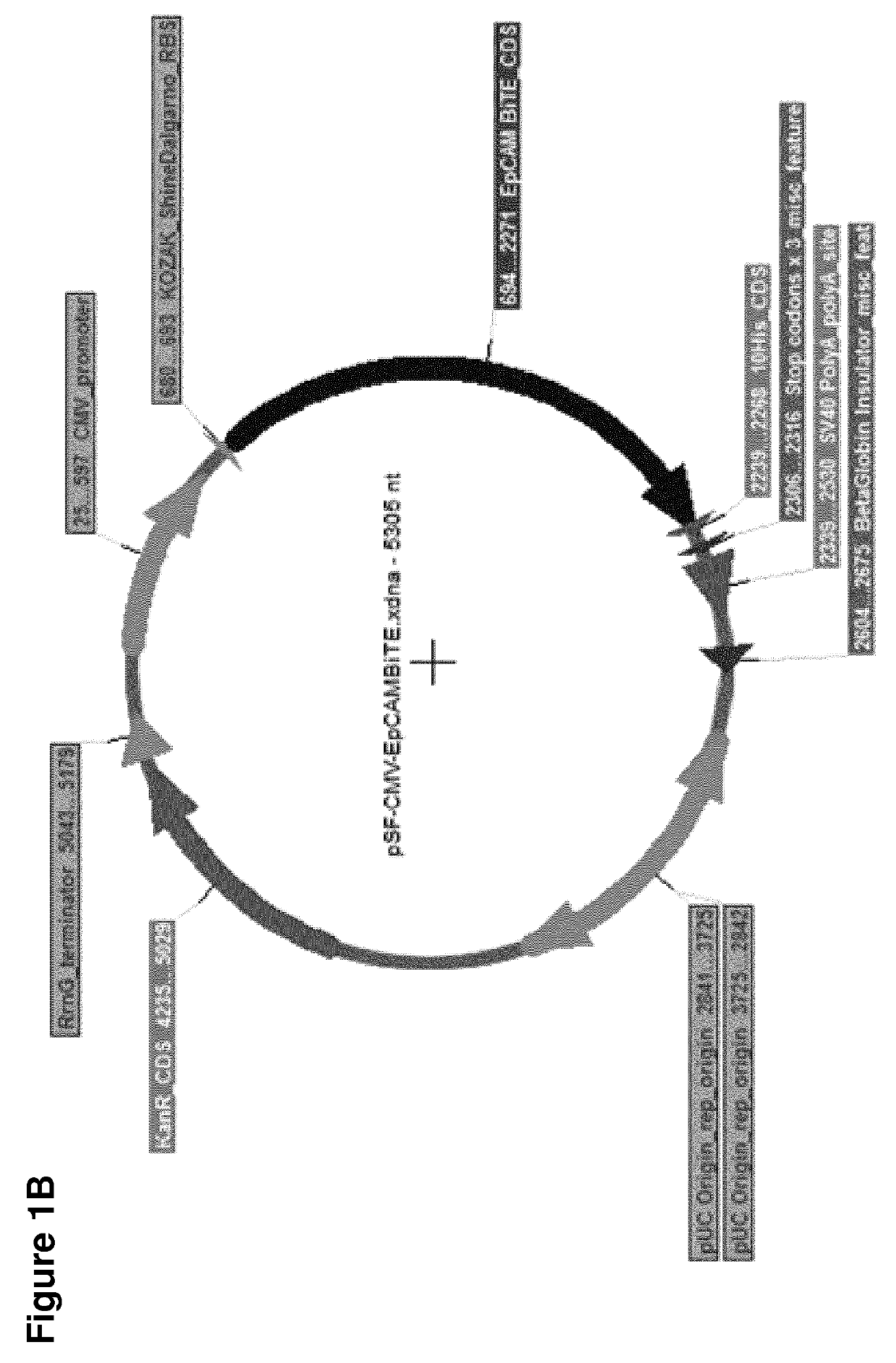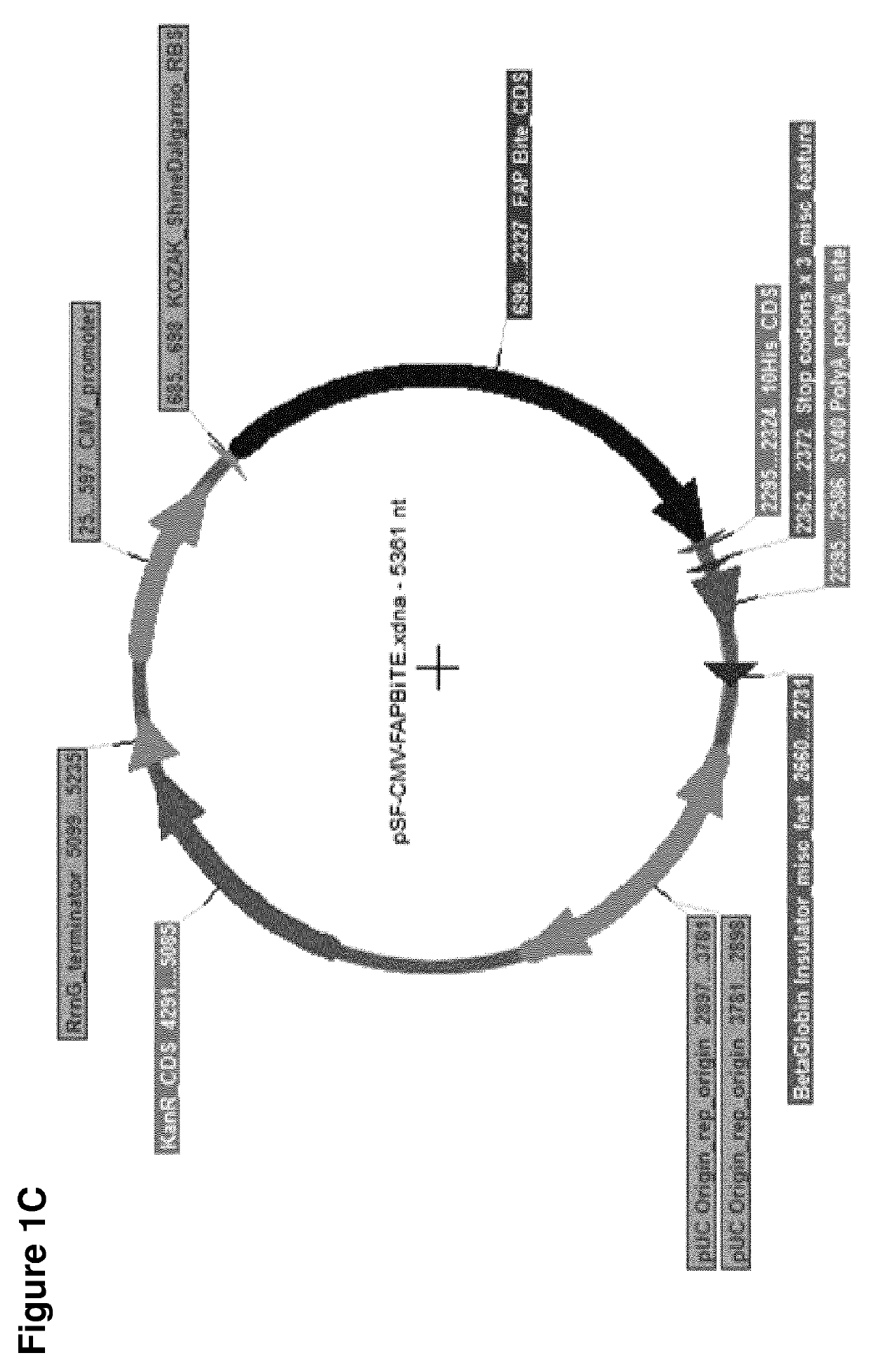Adenovirus armed with bispecific t cell engager (BITE)
- Summary
- Abstract
- Description
- Claims
- Application Information
AI Technical Summary
Benefits of technology
Problems solved by technology
Method used
Image
Examples
example 1
[0842]Recombinant BiTEs were designed and proteins produced as described in this example.
BITE Engineering
[0843]BiTEs are generated by joining two single chain antibody fragments (ScFv) of different specificities with a flexible Gly4Ser linker. ScFv's are created by the joining of VH and VL domains from parental monoclonal antibodies by a linker. Each BiTE was designed with an N-terminal signal sequence for mammalian secretion and a C-terminal decahistidine affinity tag for detection and purification. BiTEs were engineered by standard DNA cloning techniques and inserted into protein expression vectors (FIG. 1). The anti-EpCAM BiTE is that from patent WO 2005040220 (SEQ ID NO: 63 therein), with a signal sequence and affinity tag added. The anti-FAP BiTE was created de novo using the anti-FAP ScFv from patent WO2010037835A2 and the anti-CD3 ScFv from patent WO 2005040220 (SEQ ID 63 therein), with a signal sequence and affinity tag added. A control BiTE used the anti-FHA (filamentous he...
example 2
[0849]The functional activities of recombinant BiTE proteins were assessed in a number of different assays prior to constructing BiTE transgene-bearing EnAd viruses.
Isolation of Human Peripheral Blood Mononuclear Cells (PBMCs)
[0850]Human PBMCs were isolated by density gradient centrifugation either from fresh human blood samples of healthy donors or from whole blood leukocyte cones, obtained from the NHS Blood and Transplant UK in Oxford. In either case, the samples were diluted 1:2 with PBS and 25 mL of this mixture was layered onto 13 mL Ficoll (1.079 g / mL, Ficoll-Paque Plus, GE Healthcare) in a 50 mL Falcon tube. Samples were centrifuged (Allegra X-15R, Beckman Coulter) at 1600 rpm for 30 minutes at 22° C. with the lowest deceleration setting to preserve phase separation. After centrifugation, 4 layers could be observed which included a plasma layer at the top, followed by an interface containing PBMCs, a Ficoll layer and a layer of red blood cells and granulocytes at the bottom....
example 3
[0857]A similar set of experiments to those in example 2 were run to characterize the recombinant EpCAM BiTE protein.
Characterisation of Human T-Cell Activation by Recombinant EpCAM BiTE
[0858]The ability of the EpCAM BiTE to induce T-cell activation in the presence or absence of the EpCAM-positive DLD cell line was compared. Human CD3+ T-cells (70,000 cells per well in 96-well U-bottom plates) were co-cultured alone or with DLD cells (10:1 T:DLD) in the presence of media alone or 600 ng / mL EpCAM or control BiTE. Cells were co-cultured for 24 hours at 37° C. and subsequently harvested with enzyme-free cell dissociation buffer. The expression levels of CD69 and CD25 on CD45+ T-cells were then analysed by antibody staining and flow cytometry and data represented as geometric mean fluorescence (gMFI) values. Plate-immobilised anti-CD3 antibody (7.5 μg / mL) was used as positive control for T cell activation. The EpCAM BiTE selectively induced the expression of activation markers CD69 and ...
PUM
| Property | Measurement | Unit |
|---|---|---|
| Fraction | aaaaa | aaaaa |
| Time | aaaaa | aaaaa |
| Temperature | aaaaa | aaaaa |
Abstract
Description
Claims
Application Information
 Login to View More
Login to View More - R&D
- Intellectual Property
- Life Sciences
- Materials
- Tech Scout
- Unparalleled Data Quality
- Higher Quality Content
- 60% Fewer Hallucinations
Browse by: Latest US Patents, China's latest patents, Technical Efficacy Thesaurus, Application Domain, Technology Topic, Popular Technical Reports.
© 2025 PatSnap. All rights reserved.Legal|Privacy policy|Modern Slavery Act Transparency Statement|Sitemap|About US| Contact US: help@patsnap.com



